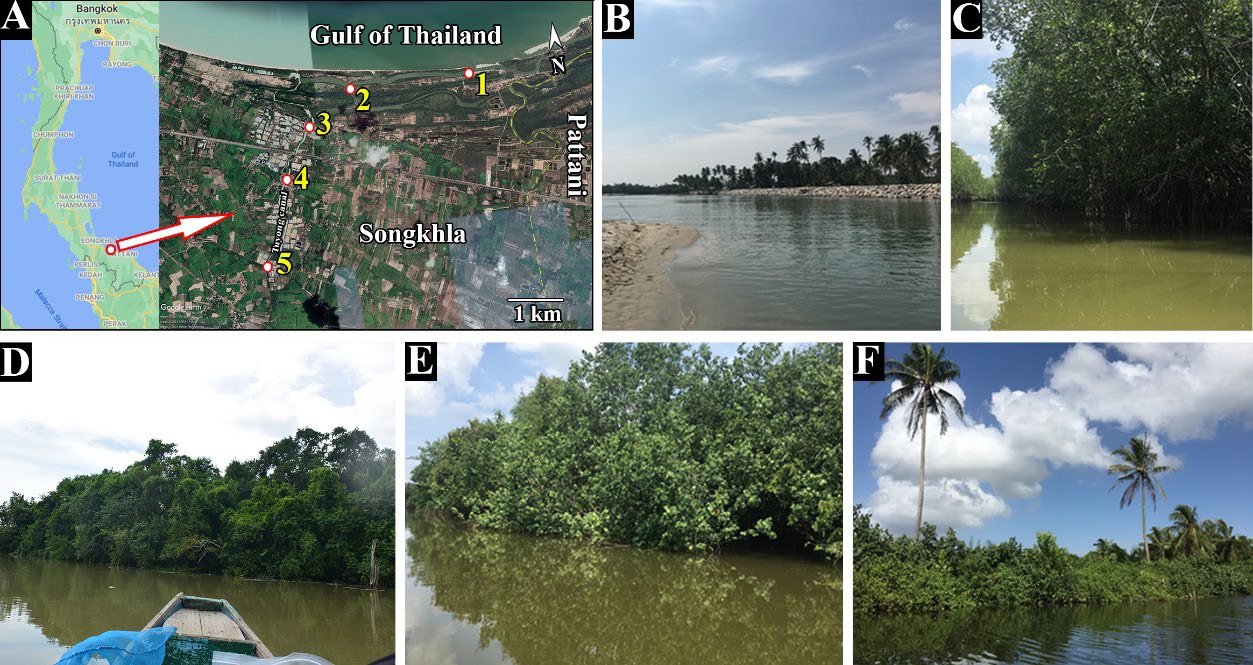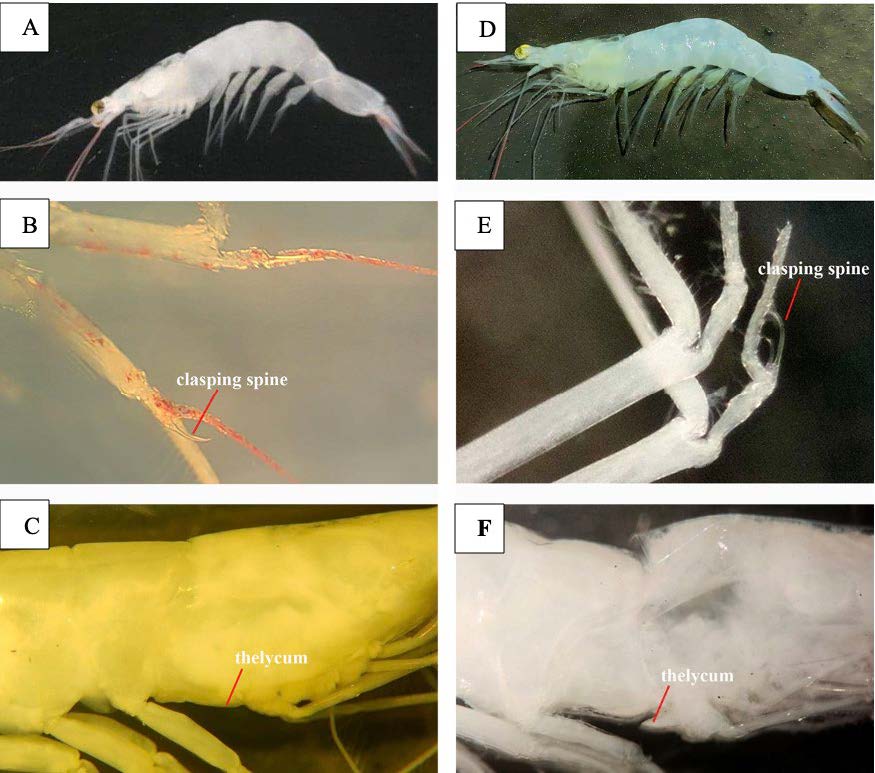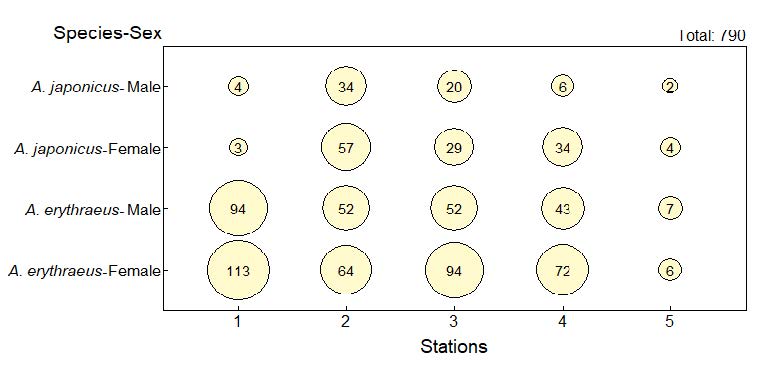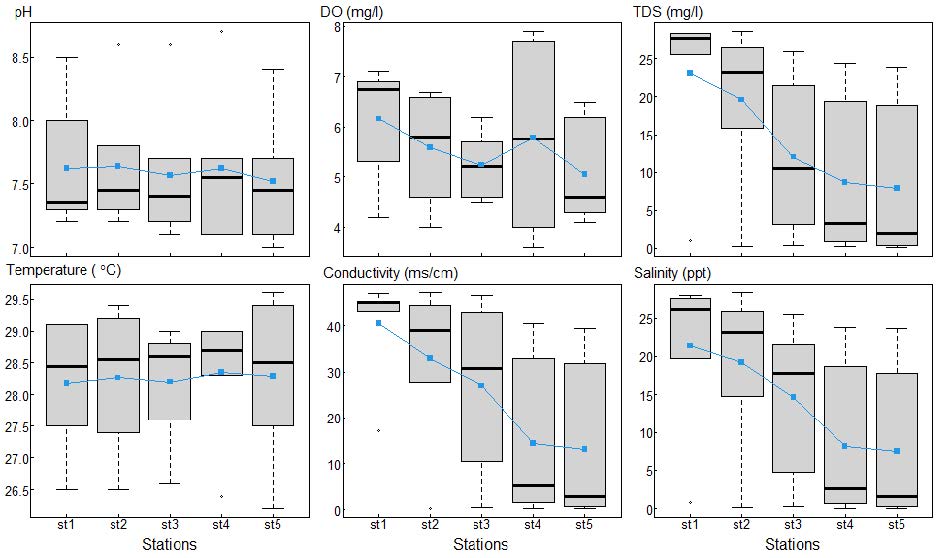
Species Composition and Distribution of Acetes in Tuyong Canal, Thepha District, Songkhla Province, Thailand
Supaporn Saengkaew, Kua Rittiboon*, Somsak Buatip, Chavapot Chavavongsa, and Wiraya ChuchotePublished Date : 2023-01-05
DOI : https://doi.org/10.12982/NLSC.2023.013
Journal Issues : Number 1, January-March 2023
Abstract This research aimed to study species composition and water characteristics affecting Acetes distribution in Tuyong canal, Thepha district, Songkhla province, Thailand. Based on 790 samples were collected from the five stations located along the canal by using the scoop net during October 2020 to March 2021. The result showed that Acetes erythraeus and Acetes japonicus were found in the Tuyong canal, Thepha district, Songkhla province. A. erythraeus was the dominant species found and had exhibited a peak season in January 2021 which happen to be after the monsoon season. It was found overall station and month, whereas A. japonicus was not found on November and December. Acetes spp. were found in abundance at the stations close to the mouth of the canal, compared to the stations located to inside canal. The Pearson correlation indicated that Acetes distribution was positively related to pH, dissolved oxygen (DO), total dissolved solids concentration (TDS), temperature, conductivity and salinity. The regression model showed a significant relationship between parameter of species, time, station, pH and temperature with Acetes distribution. Acetes had a mean weight of 42.27 ± 32.51 mg and a body length of 15.25 ± 5.31 mm A. erythraeus was found to be larger than A. japonicus. In both species of Acetes, males were larger than females. Acetes-sex ratio was favorite in females.
Keywords: Acetes, Distribution, Thepha district, Songkhla
Citation: Saengkaew, S., Rittiboon, K., Buatip, S., Chavavongsa, C., and Chuchote, W. 2023. Species composition and distribution of Acetes in Tuyong canal, Thepha district, Songkhla province, Thailand. Nat. Life Sci. Commun. 22(1): e2023013.
INTRODUCTION
Acetes is a scientific name that refers to a genus of small shrimp. The total length of Acetes body is from 10-40 mm. They are characterized by the loss of the fourth and fifth pairs of pereiopods, shorter and smaller rostrum than that of penaeids, three pairs of pereiopod, five pairs of pleopod, and the number of red spots on the uropod (Xiao and Greenwood, 1993). The species of Acetes are found in abundant in the coastal areas of certain geographical location such as seagrass bed, mudflat, coarse-sand flats, mangroves, and open water (Detsri et al., 2019). However, they can also exist in close shore habitats such as estuaries and brackish water which has a low salinity environment. Zafar and Alam (1997) found Acetes erythraeus in the Kutubdia channel of Bangladesh coastal water with salinity range between 9.70 ppt and 30 ppt. Occasionally, they can be found distributed into the inner fresh river by tidal influence (Colefax, 1940). There are 14 species of Acetes found widely distributed in many habitats in the world (Omori, 1975; Xiao and Greenwood, 1993). Acetes can be found in Thailand including A. japonicus, A. erythraeus, A. vulgarism, A. sibogae, A. indicus, and A. Serrulatus (Omori, 1975; Xiao and Greenwood, 1993; Pengchumrus and Upanoi, 2005; Datsri, 2012). They assume a significant part in the coastal ecosystem by connecting the primary producers; phytoplankton, the primary consumer; zooplankton, and living things at higher trophic levels (Xiao and Greenwood, 1993). In Thailand, Acetes is considered as an important economical shrimp mainly for making shrimp paste. Shrimp paste is an essential ingredient used in various recipes in Southeast Asia and is distinguished in its taste and foodstuff (Omori, 1975; Xiao and Greenwood, 1993). In Thepha district, the existence of these shrimps provide local fishermen with extra income during its season. Tuyong canal is located in Thepha district, Songkhla province, and is connected to the Gulf of Thailand in Pak Bang subdistrict. It is covered with mangroves along both sides of the coasts for good support as their habitats (Rönnbäck et al., 1999). However, the villagers found that the Acetes production in this canal tends to decrease recently, and this area has yet to be studied intensively with regards to the existence and production of Acetes. In line with the above mentioned situations, the objectives of this study are to investigate species composition and distribution of Acetes as well as factors affecting Acetes distribution in Tuyong canal that later may become a baseline data for sustainable Acetes production.
MATERIALS AND METHODS
Sample collection and identification
Samples of Acetes specimens were collected from five stations (6.8513N, 101.0342E to 6.8238N, 100.9977E) in the Tuyong canal connecting to the Gulf of Thailand at Thepha district, Songkhla province, Thailand during October 2020 to March 2021 (Figure 1). The two sides of the canal are covered by mangrove vegetation mainly Sonneratia sp. and Rhizophora sp. from estuary to the inner part of the canal which was selected as sampling sites from station one to three. Station four to five were located next to station three consisting of poor mangrove vegetation mainly Hibicus tiliaceus, with the adjacent land consisting of shrimp ponds. Each station was seperated within the distance of two kilometers from each other. The samples were collected along both sides of the canal closely with mangrove vegetation from the water surface of one to two meters depth and at a frequency of one time per month.
The scoop net (mesh size 0.20-0.30 mm) was used to catch the Acetes for 10 minutes at a time during the morning time. Specimens were stored with ice immediately after field assembling and carried to the laboratory for further study. In the laboratory, Acetes specimens were identified by using a stereomicroscope and taxonomic reference Omori, 1795). The sex of adult Acetes erythraeus was determined by the presence or absence of one clasping spine on the lower antennular flagellum and coupling folds on petasma. Acetes Japonicus was determined by the presence or absence of two clasping spines on the lower antennular flagellum and the form of the third thoracic sternum (Omori, 1795). The specimens are deposited at the Ecological Unit Laboratory, Faculty of Science and Technology, Prince of Songkla University, Pattani Campus.
Size of Acetes specimens
The total length of Acetes specimens from the tip of the rostrum to the end of telson (Figure 2) was measured by a digital Caliper (model LDC15B) and the total weight was taken by a digital balance of 0.001 g accuracy to establish the length-weight relationship.
Water parameters
Water temperature, dissolved oxygen (DO), pH, salinity, conductivity, and total dissolved solids (TDS) at each station were measured with the YSI Digital Water Quality Meter (model 550A and model pro 1030) at water depths 30-50 cm from the water surface.
Data analysis
Data analysis: R program version 4.0.3 was used to analyze data and produce graphical presentations. In this study, the Pearson correlation was used to analyze the relationship between water parameters, and Acetes count while multiple regression with count logarithmic transformations (+1) was used to identify factors affecting Acetes distribution.

Figure 1. A: Geographical location of the sampling stations (one to five: B-F) in the Tuyong canal, Thepha district, Songkhla province.

Figure 2. Measuring the total length (TL) of Acetes.
RESULTS
Species composition and distribution of Acetes
In this study, Acetes had a mean weight of 42.27 ± 32.51 mg and a body length of 15.25 ± 5.31 mm Acetes erythraeus was found to be larger than A. japonicus. In both species of Acetes, males were larger than females.
A. erythraeus and A. japonicus were found in this area study (Figure 3). According to the tidal influence, Acetes spp. were found in abundance at the stations close to the mouth of the canal (stations one, two, and three), compared to the stations next to the canal (station four and five). The lowest number of Acetes species were found at the station five being far from the sea (Figure 4). The highest number of both species were found in January 2021 with salinity varied by 2.30 - 27.50 ppt. We haven’t found A. japonicus on November and December in Tuyong canal. The results showed that A. erythraeus was the predominant species of Acetes shrimp (Figure 5).

Figure 3. Acetes erythraeus (A-C) B: male: one clasping spine, C: female Acetes japonicus (D-F) E: male: two clasping spine F: female

Figure 4. Bubble plot: distribution of Acetes in each study site during October 2020 to March 2021.

Figure 5. Bubble plot: distribution of Acetes in each month during October 2020 to March 2021.
Environmental factors
Water quality of Tuyong canal; pH, DO, TDS, temperature, conductivity, and salinity were presented in boxplot (Figure 6 and Figure 7). The highest value of TDS, conductivity, and salinity was found in station one and their values gradually decreased until station five with the lowest value. The mean value of pH, DO and temperature was relatively constant between 7.52-7.62, 5.05-6.17 mg/l, and 28.18-28.35°C, respectively (Figure 6)

Figure 6. Boxplot: Water parameters of each station during October 2020 to March 2021.
The lowest value of TDS, conductivity, and salinity was found in December which naturally happen to be the rainy season. Their values gradually increased until March with the highest value. The highest value of pH was 8.70 in January. There are two groups of DO values such as the group of low value and the group of high value. The Group of low values occurred during October to December whereas the group of high values occurred during January to March. The water temperature was during 26.44 to 29.02°C (Figure 7).

Figure 7. Boxplot: Water parameters of each month during October 2020 to March 2021.
Relationship between water parameter and Acetes distribution
Relationship between water parameter and Acetes distribution were explored by Pearson correlation. The results indicated that water parameter was related to each parameter. It was possible to explain another variable with connected variables such as total dissolved solids concentration (TDS), conductivity and salinity. Acetes distribution was positively related to pH, dissolved oxygen (DO), total dissolved solids concentration (TDS), temperature, conductivity and salinity (Table 1).
Table 1. Water quality and species count correlation in Tuyong canal, Thepha district, Songkhla province between October 2020 and March 2021.
|
pH |
DO |
TDS |
Temperature |
Conductivity |
Salinity |
Schidepth |
Depth |
spCount |
|
|
pH |
1 |
0.299 |
-0.214 |
-0.566 |
-0.267 |
-0.253 |
-0.124 |
0.111 |
0.252 |
|
DO |
0.299 |
1 |
0.534 |
0.207 |
0.544 |
0.552 |
-0.115 |
0.284 |
0.237 |
|
TDS |
-0.214 |
0.534 |
1 |
0.502 |
0.912 |
0.945 |
-0.217 |
0.044 |
0.296 |
|
Temperature |
-0.566 |
0.207 |
0.502 |
1 |
0.53 |
0.546 |
0.201 |
-0.045 |
0.072 |
|
Conductivity |
-0.267 |
0.544 |
0.912 |
0.53 |
1 |
0.978 |
-0.253 |
-0.037 |
0.278 |
|
Salinity |
-0.253 |
0.552 |
0.945 |
0.546 |
0.978 |
1 |
-0.218 |
-0.057 |
0.281 |
|
Schidepth |
-0.124 |
-0.115 |
-0.217 |
0.201 |
-0.253 |
-0.218 |
1 |
0.265 |
-0.017 |
|
Depth |
0.111 |
0.284 |
0.044 |
-0.045 |
-0.037 |
-0.057 |
0.265 |
1 |
-0.148 |
|
spCount |
0.252 |
0.237 |
0.296 |
0.072 |
0.278 |
0.281 |
-0.017 |
-0.148 |
1 |
Multiple regression with logarithmic transformation as equation log(y+1) = b0 + b1x1 + b2x2 +...+ bkxk + e was used to analyze Acetes distribution. The results revealed that predictors affecting Acetes spp. distribution were species (P-value: 0.017), time (P-value: 0.0001), study site (P-value: < 0.009), pH (P-value: < 0.023) and water temperature (P -value: < 0.0001) with R2 = 32 %. The female A. erythraeus was found with the highest number. There were the largest of Acetes spp. on January while the lowest number of Acetes species found station five being beyond to sea (Figure 8).

Figure 8. 95% confidence interval of Acetes distribution during October 2020 to March 2021.
DISCUSSION
In this study, Acetes erythraeus was the predominant species of Acetes shrimp similar to the study of Zafar and Alam (1997). In contrast, Pengchumrus and Upanoi (2005) reported that A. japonicus and A. indicus were the dominant species in seagrass and mangrove forests in Krabi, Phang Nga, and Phuket provinces. The study in the Merbok River on the coast of Kedah, Malaysia revealed that A. japonicus was the dominant species which happen to be the same as the study in Talet Yai bay, Nakhon Si Thammarat province, Thailand (Amani et al., 2011; Datsri, 2012). In this study, the Acetes shrimps were also found in the post larva and juvenile stages. Four species of Acetes shrimps; A. japonicus, A. erythraeus, A. vulgaris, and A. indicus were found in five different habitats of the Talet Yai bay: seagrass bed, mudflat, coarse-sand flats, mangroves, and open water at Nakhon Si Thammarat province, Thailand (Detsri et al., 2019). Three species of Acetes shrimps viz., A. erythraeus, A. japonicus, and A. vulgaris were found in five different coastal sites in Rayong province, Thailand including; Pang Rad estuary, Pra Sae estuary, Laem Mae Pim beach, Suan Son beach, and Pla beach (Tangkrock-olan et al., 2019). Three species of the Acetes namely; A.erythraeus, A. indicus, and A. japonicus were found in the mangrove canals and seagrass beds (Pengchumrus and Upanoi, 2005). Four species of Acetes population; A. erythraeus (38.50 %), A. indicus (32.98 %), A. chinensis (4.48 %), and A. japonicus (3.32 %) were identified in the Kutubdia channel of Bangladesh coastal waters (Zafar and Alam, 1997). Five species of sergestid shrimps viz., A. indicus, A. japonicus, A. intermedius, A. Vulgaris, and A. serrulatus were distributed in different coastal waters of Malaysia (Amani et al., 2011). The number of species found in this study were less than that of all other studies cited above. This is probably caused by the limitations of the tool and time period for collecting samples, affecting to access both the number of species and individuals.
Relationship between water parameters and distribution of Acetes
The researchers explored relationship between water parameters and Acetes distribution by using Pearson correlation. It not only showed relationship between each other’s water parameter, but also relationship between water parameter and Acetes distribution.
In this study, Acetes distribution was positively related to pH, dissolved oxygen (DO), total dissolved solids concentration (TDS), conductivity and salinity (Table 1). In contrast, the Acetes shrimps of the Kutubdia channel showed no significant relationship with the reported hydrological factors; Acetes indicus and A. erythraeus showed negative relation, while A. chinensis and A. japonicus were positively related to salinity (Zafar and Alam, 1997). Similar result was found in at in Talet Yai bay, Nakhon Si Thammarat province whereby the abundance of A. japonicus and A. vulgaris were positively related to salinity and chlorophyll-a, while A. erythraeus and A. indicus showed no relationship to any of the environmental parameters (Datsri, 2012). In the study on the population dynamics of A.americanus near a coastal upwelling region of Brazil, they found abundant of species in temperatures closer to 20.0°C and in months with high chlorophyll-a levels (Santos et al., 2015). Although those studies showed no significant relationship with water parameters, most of them had still shown that A. japonicas was positively related to salinity (Zafar and Alam, 1997; Datsri, 2012). In contrast to this study, A. erythraeus and A. japonicus were positively related to temperature and pH. The study of Acetes in five rivers of Sundarbans mangrove in southwest Bangladesh suggested that Acetes spp. were abundant in great salinity and temperature (Hoq et al., 2006; Simões et al, (2013). This finding was in agreement with our study which showed the high number of Acetes was related to the higher temperature (> 28.55°C) (Figure 7). Depth was also found to be a determining factor in the spatial distribution of the A. americanus, which showed a partiality for shallow habitats with high temperature and lower salinity. The abundance of Acetes shrimps is not only associated with water parameters but also light and tidal cycles. Xiao and Greenwood (1993) revealed that fluctuations in A. sibogae abundance were linked to light and tidal rhythm at each sampling site with higher amounts at nighttime and during high tides. It was noticed that an effect of each environmental factor on Acetes shrimps distribution was still related in parallel to each other’s factor. Therefore, co-factors should be considered for explanation of the relationship between environmental factors and Acetes shrimps distribution.
CONCLUSION
Two species of Acetes shrimps; A. erythraeus and A. japonicus were found in Tuyong canal, Thepha district, Songkhla province, Thailand. A. erythraeus was the dominant species and it was found overall station and month. Acetes spp. were found in abundance at the stations close to the mouth of the canal, compared to the stations located to inside canal. Acetes had a mean weight of 42.27 g and a body length of 15.25 mm A. erythraeus was found to be larger than A. japonicus. In both species of Acetes, males were larger than females. With using Pearson correlation analysis, Acetes distribution was positively related to pH, dissolved oxygen (DO), total dissolved solids concentration (TDS), conductivity and salinity. With fitting regression model, the distribution of Acetes in Tuyong canal showed a significant relationship with species, time, station and water parameters including pH and temperature. These predictors were able to predict presence of Acetes species by 32%. In this study, shrimp samples were collected only during the daytime for 6 months. Hence, it is necessary for future research on Acetes community to study both day and nighttime, and throughout the year. Furthermore, the study period should be covered overall year or season for a more consistent analysis.
ACKNOWLEDGEMENTS
This study is part of the project work of the Natural History Museum and Local Learning Network. The project work was funded by Faculty of Science and Technology, Prince of Songkla University. The authors would like to acknowledge Assoc. Prof. Phattrawan Tongkumchum for checking the statistical analysis. We are also thankful to Assoc. Prof. Dr. Sommai Chiayvareesajja and Language Center, PSU Pattani for approving the use of English language in this article.
AUTHOR CONTRIBUTIONS
Gratitudes are addressed to the contributors as follows; Supaporn Saengkaew, Kua Rittiboon, and Somsak Buatip who have contributed to the design and implementation of the research. Somsak Buatip in the identification of the samples of species. Kua Rittiboon in performing the statistical analysis and taking the lead in writing the manuscript. Chavapot Chavavongsa in carrying out the fieldwork. Wiraya Chuchote in assisting to carry out the fieldwork and the laboratory work. Last but not least to all authors who have unanimously approved the research content, analysis, and manuscript.
CONFLICT OF INTEREST
The authors declare that they hold no competing interests.
REFERENCES
Amani, A.A., Arshad, S.M.N., and Aziz, N.A.A. 2019. Catch composition of a set bag net used for Acetes trapping in the estuarine waters of Kedah, Peninsular Malaysia. Journal of Fisheries and Aquatic Sciences. 6: 279-284.
Colefax, A.N. 1940. An Australian species of Acetes (Crustacea Macrura, Sergestidae), with remarks on the distribution and literature of the genus. Records of the Australian Museum. 20: 341–353.
Datsri, U. 2012. Species composition, habitat uses of Acetes shrimps at Talet Yai Bay, Nakhon Si Thammarat and the Influence of Predator (Secutor insidiator) on Habitat Selection of Acetes japonicus. M.S. Thesis, Walailak University, Nakhonsrithommarat, Thailand.
Detsri, U., Satapoomin, S., and Darumas, U. 2019. Community structure of Acetes shrimps in the Gulf of Thailand with notes on influence of predatory fish Secutor insidiator on habitat selection of Acetes japonicus. Phuket Marine Biological Center Research Bulletin. 76: 71-84.
Hoq, M.E., Wahab, M.A., and Islam, M.N. 2006. Hydrographic status of Sundarbans mangrove, Bangladesh with special reference to post-larvae and juveniles fish and shrimp abundance. Wetlands Ecology and Management. 14: 79-93.
Omori, M. 1975. The Systematics, biogeography, and fishery of epipelagic shrimps of the genus Acetes (Crustacea, Decapoda, Sergestidae). Bulletin of the Ocean Research Institute University of Tokyo. 7: 1-91.
Pengchumrus, W., and Upanoi, T. 2005. Species and distribution of Acetes shrimps in seagrass beds and mangrove canals in the Andaman Sea. Technical Paper of Phuket Marine Biological Center. Phuket. 12: 21 pp. (in Thai; English abstract)
Rönnbäck, P., Troell, M., Kautsky N., and Primavera, J. 1999. Distribution pattern of shrimps and fish among Avicennia and Rhizophora microhabitats in the Pagbilao Mangroves, Philippines. Estuarine, Coastal and Shelf Science. 48: 223-234.
Santos, A.P. FD., Simões, S.M., Bochini, G.L., Costa, C.H., and Costa, R.C.D. 2015. Population parameters and the relationships between environmental factors and abundance of the Acetes americanus shrimp (Dendrobranchiata: Sergestidae) near a coastal upwelling region of Brazil. Brazilian Journal of Oceanography. 63: 229-238.
Simões, S., Castilho, A., Fransozo, A., Negreiros-Fransozo, M., and Da Costa, R. 2013. Distribution related to temperature and salinity of the shrimps Acetes americanus and Peisos petrunkevitchi (Crustacea: Sergestoidea) in the south-eastern Brazilian littoral zone. Journal of the Marine Biological Association of the United Kingdom. 93: 753-759.
Tangkrock-olan, N., Phudhom, A., Charoenjit, K., and Hrimpeng, K. 2019. Species of Acetes shrimps (Decapoda; Sergestidae) along the coast of Rayong province. Burapha Science Journal. 24: 568-580.
Xiao, Y., and Greenwood, J.G. 1993. The biology of Acetes (Crustacea; Sergestidae). Oceanography and Marine Biology: An Annual Review. 31: 259–444.
Zafar, M. and Alam, M.D. 1997. Occurrence and abundance of Acetes shrimps in the Kutubdia channel of Bangladesh coastal water. Bangladesh Journal of Fisheries Research. 1: 91-96.
OPEN access freely available online
Natural and Life Sciences Communications
Chiang Mai University, Thailand.
Supaporn Saengkaew1, Kua Rittiboon1, *, Somsak Buatip1, Chavapot Chavavongsa1, and Wiraya Chuchote2
1 Faculty of Science and Technology, Prince of Songkla University, Pattani 94000, Thailand.
2 (student), Faculty of Education, Prince of Songkla University, Pattani 94000, Thailand.
*Corresponding author: Kua Rittiboon, E-mail: kua.r@psu.ac.th
Total Article Views
Editor: Wasu Pathom-aree,
Chiang Mai University, Thailand
Article history:
Received: May 14, 2022;
Revised: November 8, 2022;
Accepted: November 15, 2022;
Published online: November 18, 2022

